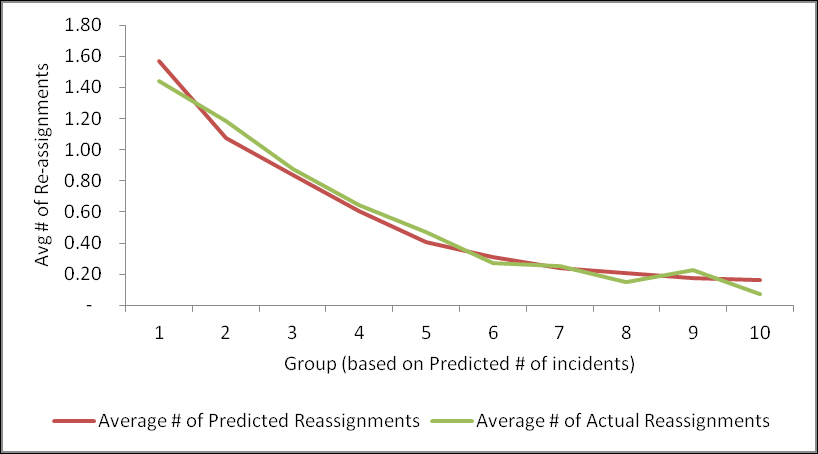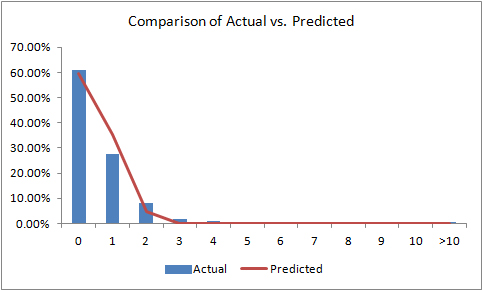Summary
Predictive analytics techniques were deployed to predict the frequency of an IT Ticket getting reassigned in an online IT service management application. A robust predictive regression model was built, despite the predictor variables being largely categorical in nature. Poisson regression techniques were deployed to circumvent the non-normal behaviour exhibited by the target variable. The regression model enabled effective workforce planning to resolve IT incidents, based on the predicted reassignment frequency of the associated IT Ticket. The model also provided early warning signals of likely multiple reassignments, allowing better proactive management of high-priority IT incidents.
Business Backdrop
The client is a US-based provider of online IT service management products & solutions. The client’s product suite addresses its end-users’ IT service management needs through efficient routing of IT incidents (service requests) to appropriately-skilled service agents. For each service request received at the end-user’s site, an associated IT Ticket is assigned to a service agent.
The performance of an IT service management system hinges critically on the robustness of the assignment of IT incidents (through IT Tickets) to service agents who attend to such IT incidents and resolve them. IT incidents can either be pre-recorded in internal systems (as is the case with scheduled software installation, upgrades, etc) or arrive at the IT service desk in a dynamic fashion (such as requests for bug fixes, unscheduled outages, etc). IT Incident Queue Management is very subjective due to the inherent nature of a typical IT service desk. Organizations have a number of popular queue-system designs to choose from, such as, single-queue single-desk, single-queue multiple-desk, multiple-queue single-desk, and multiple-queue multiple-desk. Across the world, there are many organizations that have extracted desired throughput levels from their service desks via the single-queue multiple-desk approach, as there are many others that prefer to deploy the multiple-queue multiple-desk configuration.
What works best for a particular organization depends substantially on its queue-system design and the mechanism used to assign IT incidents to service agents, apart from the depth & breadth of the skills & competencies of its service desk personnel. The best throughput is achieved when an IT incident is assigned to an agent that can resolve the incident in the least time. Hence, assigning an IT incident (i.e., the associated IT Ticket) to the ‘right’ service agent is a critical success factor for an effective & efficient IT service management system. Failure to assign the IT incident to the appropriate service agent necessitates subsequent reassignment of the IT Ticket (sometimes multiple reassignments), leading to delays in problem resolution and erosion of customer satisfaction levels.
Accordingly, it is imperative to minimize the need to reassign an IT Ticket and, to this end, predict the number of times an IT incident gets reassigned.
Analytical Approach
To predict the number of times an IT incident (or Ticket) gets reassigned, exploratory analysis was conducted on data sourced from the back-end database. The number of reassignments could depend on a number of factors, such as priority of the Ticket, severity of the problem, impact of the problem, location of the problem, reporting mode of the incident, location of the problem, type of the problem, etc. Data was available for over 150,000 IT incidents, and there were around 75 variables to describe the particulars of each incident.
While predicting the number of times an IT incident gets reassigned is of direct interest to the client, there is additional value in understanding if certain characteristics of an IT incident increase/ decrease the reassignment frequency of the said incident. Accordingly, whereas a straight-forward analytical approach involved Predictive Modelling, classification techniques were deployed as well (in particular, Segmentation) to uncover any underlying clusters among the IT incidents.
Challenges
Standard predictive modelling techniques require the predictors to be numeric in nature. Of the 75 variables available in the data, only 10 were numeric, the rest being categorical in nature. This severely limited the applicability of standard techniques like linear or non-linear regression. While categorical data can be transformed via variable binning and dummy variable creation approaches, an additional challenge was unravelled – the target variable, i.e., the number of times an IT Ticket gets reassigned, does not follow a normal distribution, a key assumption under standard linear regression models.
As a more negative exponential relationship was found and, given the inherent nature of the target variable, a Poisson regression model was deemed a better fit to the situation. Accordingly, a Poisson regression model was built using several categorical and numeric variables. The model was validated using deviance residuals and rank ordering of the regression model.
Solution Framework
The final solution was built through a Poisson regression model. The final model built rank ordered well in the development sample, and also performed significantly well with test data and validation data.
Business Benefits
Using the Poisson regression model, the client was able to predict the number of possible reassignments for an IT Ticket. Based on such prediction, the client was able to plan the workforce required to provide a resolution to the IT incident. In addition, the model provides an early warning of an IT Ticket being reassigned multiple times. Such early warning signals enable to client’s IT service team to manage high-priority IT Tickets in advance and stop escalations of such high-priority IT incidents.









